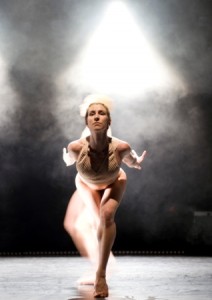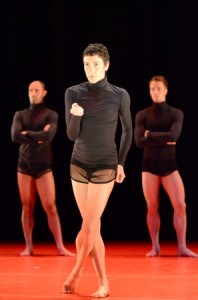JACOB’S PILLOW DANCE FESTIVAL
CARTE BLANCHE
Ted Shawn Theatre
June 30, 2011
Review by Anna Rogovoy
(BECKET, Mass.) – Over the past few years, audiences at Jacob’s Pillow and around the world have seen a number of artists whose names are tied to Ohad Naharin, artistic director of Israel’s Batsheva Dance Company — artists such as Hofesh Shechter, Andrea Miller, Barak Marshall, and, perhaps newest to Pillow audiences, Sharon Eyal. Eyal, a longtime dancer with Batsheva and current House Choreographer for the company, creates insightful, sensual, and highly physical works, as demonstrated in a powerful and beautifully performed evening of works in the U.S. debut of Carte Blanche, Norway’s national contemporary dance ensemble.
Killer Pig begins in the dark. A low drone rings out once, then again, and a spotlight is illuminated to reveal six women who appear whitewashed. The light flickers as the tableau shifts, the dancers breaking into movements with the percussive rhythm that will drive the entirety of the piece. They march on the balls of their feet and jut their shoulders forward in a swagger that is at once aggressive and alluring. They move in unison, beginning to stagger and break away from this controlled timing as their movements expand into a broader palette of idiosyncratic gestures and phrases. They flick up and grab a foot, hinge at the waist with arms contorted, and jump in the established rhythm, interspersing these motions every so often with a yell that conveys not only a desire for communication with each other, but a declaration of their humanity. These women, while they look absolutely otherworldly, are human, and this dancing reflects in many ways instinctual behaviors and desires.
Throughout the piece, ensemble sections — which are alternately in and out of unison, but consistently connected in their tone and rhythmic focus — are interspersed with solos, duets, and smaller group sequences. Often a group stands and watches a main event, and their onstage observation illuminates for the offstage audience elements of Eyal’s choreography, which is perhaps most reminiscent of Naharin’s in her ensemble sections, when the dancers explode from tautly executed stomps into deeply weighted lunges and dynamic leaps with legs and arms wildly extended. She draws on older traditions as well in a solo colored by classical ballet turns and leaps, executed with the same ease and strength as her more contemporary phrases.
Unusual and hypnotic in its intensely honed simplicity is a section in which the dancers join hands with their arms raised over their heads and, recalling a painting of Grecian princesses, slowly parade in a circle on tiptoe before breaking off again into the weighted, aggressive movement we’ve come to expect from Eyal. After this, the piece almost appears to retrograde, the dancers re-congregating in familiar formations. The lighting design, powerful throughout, shifts dramatically here: in the end, the dancers are silhouetted in a moving tableau by a row of lights on the floor upstage. It’s quite literally a different perspective on them, and evokes the theme of duality that this work has raised; the contrasts between femininity and strength or aggression, between what is natural or organic and what is manmade or fabricated.
Love, which was originally commissioned for the dancers of Batsheva, opens suddenly in media res with twelve black-clad dancers brightly lit against a red floor. Already in motion, these men and women are recognizably more human than the eerie “characters” of the preceding work, without the coating of white powder and white garments that bestowed an alien pallor on the all-female cast of Killer Pig. There’s not much variation here in the vocabularies for the male and female dancers of the company; the contrast is instead between two movement themes, which are each executed (excellently) by both genders. The established muscular, stomping, sharp aggressiveness that dominated Pig recurs here, with more attention to thrusting and jumping. This is complemented by a slow, sinuous quality and expansive, indulgent phrases that recall a ballet adagio.
There is so much contrast and so much excellent dancing in Love that the stage seems, at times, occupied by more than the dozen members of Carte Blanche. Eyal’s visual eye keeps the dancers oriented in tableaux which, even if occurring only for a second, are consistently striking, and this keeps the piece from becoming overwhelming. However, it is not until the six women are once again alone on the stage that the piece really seems to settle into itself. The music shifts to a ballad by Lisa Germano, and each dancer executes a solo, unique yet un-disparate. The others watch intently and respectfully, as if listening to a declaration. After the last solo the stage empties, music playing on for a few moments. When the lights go dark they leave us conflicted and longing for more — we’ve had the closure we sought, but what a sweet experience to let go of.
Anna Rogovoy is dance critic for The Rogovoy Report. She studies dance, literature, and writing at Bennington College.



